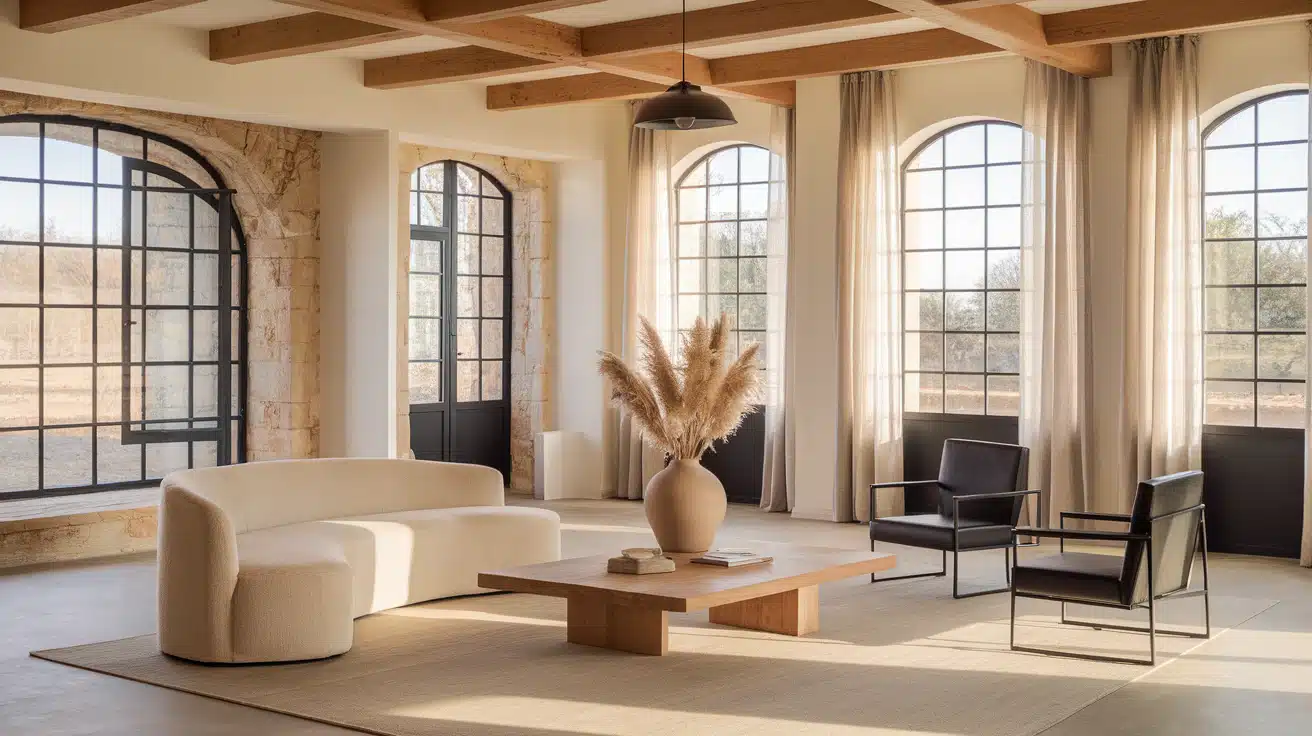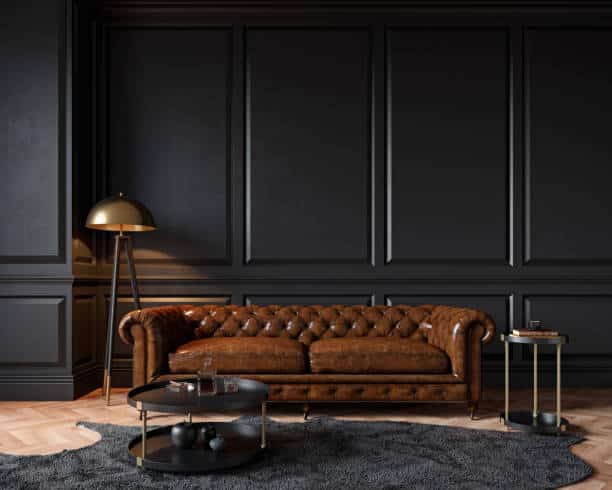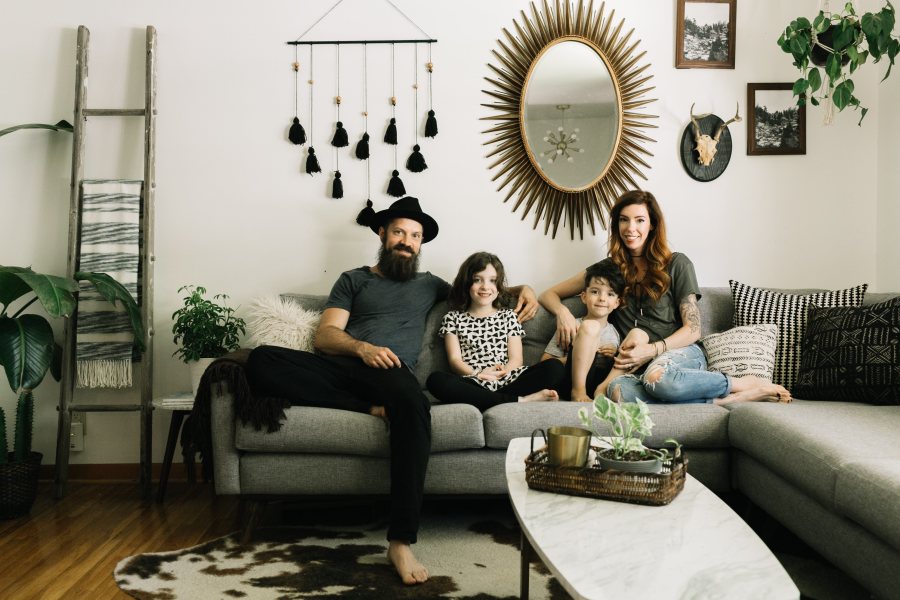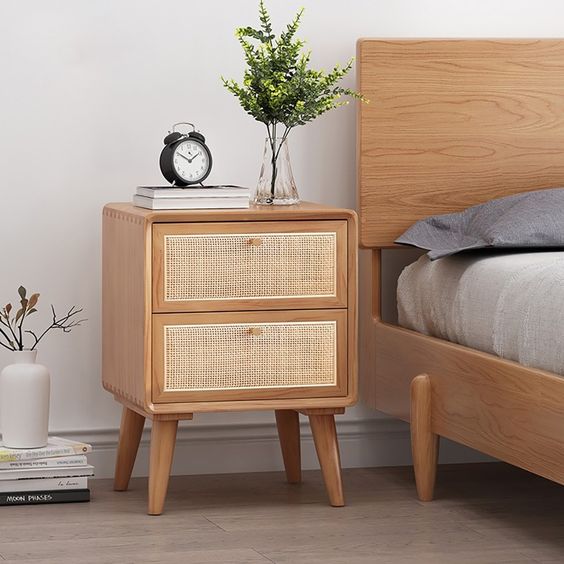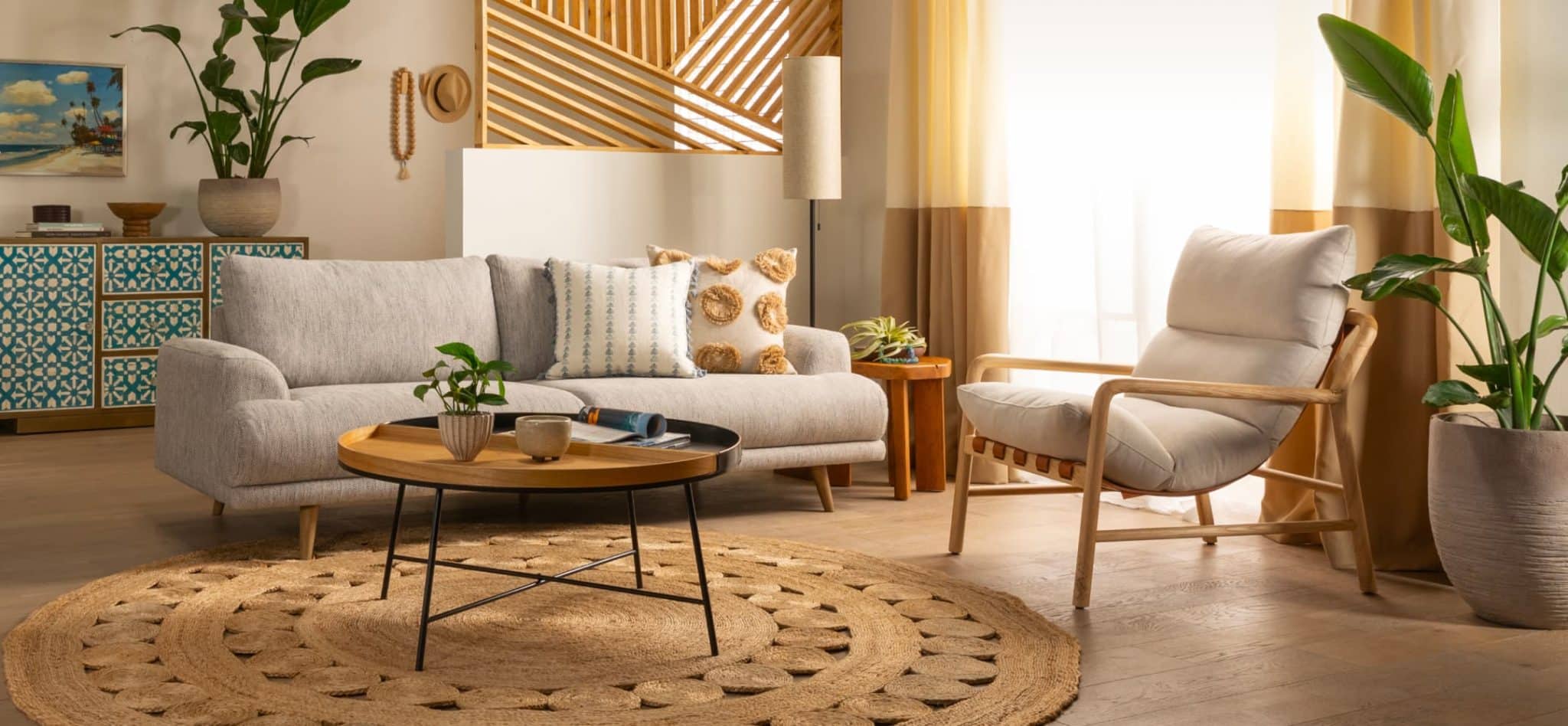Home Style Evolution: What’s Replacing Farmhouse in 2025
White walls and rustic touches shaped American homes for nearly a decade, turning country-inspired style into a household name.
This design movement influenced everything from small apartments to custom homes, setting a standard for comfortable living spaces.
As we enter 2025, homeowners seek fresh ways to personalize their spaces.
This guide explores the styles taking center stage in modern homes, offering practical tips to help you update your space while maintaining the comfort you love.
Is Farmhouse Style Going Out of Style This Year?
This year, the beloved farmhouse style, which dominated home décor for over a decade, is experiencing a significant shift.
While the core elements of comfort and warmth remain valued, many signature farmhouse features have become too familiar in homes across America.
The style’s widespread adoption, from big-box stores to luxury retailers, has made certain elements feel overused and mass-produced.
The Evolution of Farmhouse Style

Not everything farmhouse needs to be retired. Quality pieces like authentic farmhouse sinks and solid wood dining tables remain charming.
Traditional architectural elements that match a home’s natural character, such as exposed beams and original shiplap, remain relevant when used thoughtfully.
However, mass-produced items like typography signs, faux-distressed furniture, and excessive buffalo check patterns now mark a space as outdated.
Emerging Interior Design Trends Replacing Farmhouse

1. Organic Modern
This style represents a fresh take on natural living spaces. Organic Modern combines clean lines with raw materials, creating environments that feel sophisticated and connected to nature.
The style emphasizes curved forms, natural stone, and unfinished wood while maintaining a contemporary aesthetic.
Spaces feature abundant natural light and incorporate living plants as key design elements.
2. Brutalism
Surprisingly, brutalism has unexpectedly returned to residential design. Modern interpretations of this style focus on raw materials and architectural honesty.
Today’s brutalist interiors combine exposed concrete and steel with softer elements like textured fabrics and wooden accents, creating bold and welcoming spaces.
3. Mid-Century Modern Revival
The resurgence of mid-century modern design offers a refined alternative to the farmhouse style.
This trend celebrates clean lines, organic curves, and functional beauty. Modern interpretations mix authentic vintage pieces with contemporary items, creating nostalgic and fresh spaces.
This style is defined by rich woods, bold geometric patterns, and carefully chosen color accents.
4. Rustic Luxe
Rustic Luxe offers a raised approach for those wanting to maintain elements of rustic charm.
This style pairs natural materials with refined finishes and luxurious textures. Spaces feature high-quality materials like marble and brass alongside rustic wood and stone.
The result is sophisticated yet comfortable, perfect for those transitioning from traditional farmhouse style.
5. Japandi Style
Japandi design merges Japanese minimalism with Scandinavian functionality. This style emphasizes clean lines, natural materials, and thoughtful simplicity.
Spaces feature neutral colors, minimal décor, and functional beauty. The focus on craftsmanship and quality materials makes this style particularly appealing to those seeking longevity in their design choices.
6. Maximalism
In contrast to farmhouse simplicity, maximalism celebrates personal expression and bold choices.
This style encourages creative mixing of patterns, colors, and textures. Spaces feature curated collections, statement artwork, and rich color combinations.
The key lies in creating meaningful arrangements rather than simply filling space.
Key Elements and Features of the New Trends

Natural and Organic Materials
The shift toward sustainable design has placed natural materials at the forefront of home décor. Bamboo, cork, and responsibly sourced wood have become central elements in modern interiors.
These materials bring warmth and texture while supporting environmental consciousness.
Manufacturers now offer innovative options, such as mushroom-based materials and recycled composites. These alternatives provide the beauty of traditional materials while reducing environmental impact.
The focus has moved beyond mere looks to consider the full lifecycle of each material used in home design.
Color Palettes for 2025
The new color trends depart from the all-white farmhouse palette. Rich earth tones and deep forest greens create grounded, natural environments. Soft, powdery pastels offer subtle color without overwhelming spaces.
Black and white combinations have evolved beyond stark contrasts. Modern interpretations include warmer blacks and creamy whites, creating sophisticated yet welcoming spaces.
These combinations work particularly well with natural textures and materials.
Unique Architectural Details
Modern homes now feature softer lines and organic shapes. Curved walls and arched doorways replace the sharp angles common in farmhouse design. These flowing forms create visual interest while maintaining clean lines.
Stone and concrete elements appear in unexpected places. Floating vanities and built-in seating showcase these materials in fresh ways. The emphasis remains on authentic materials used in their natural state.
How to Transition from Farmhouse to a New Style
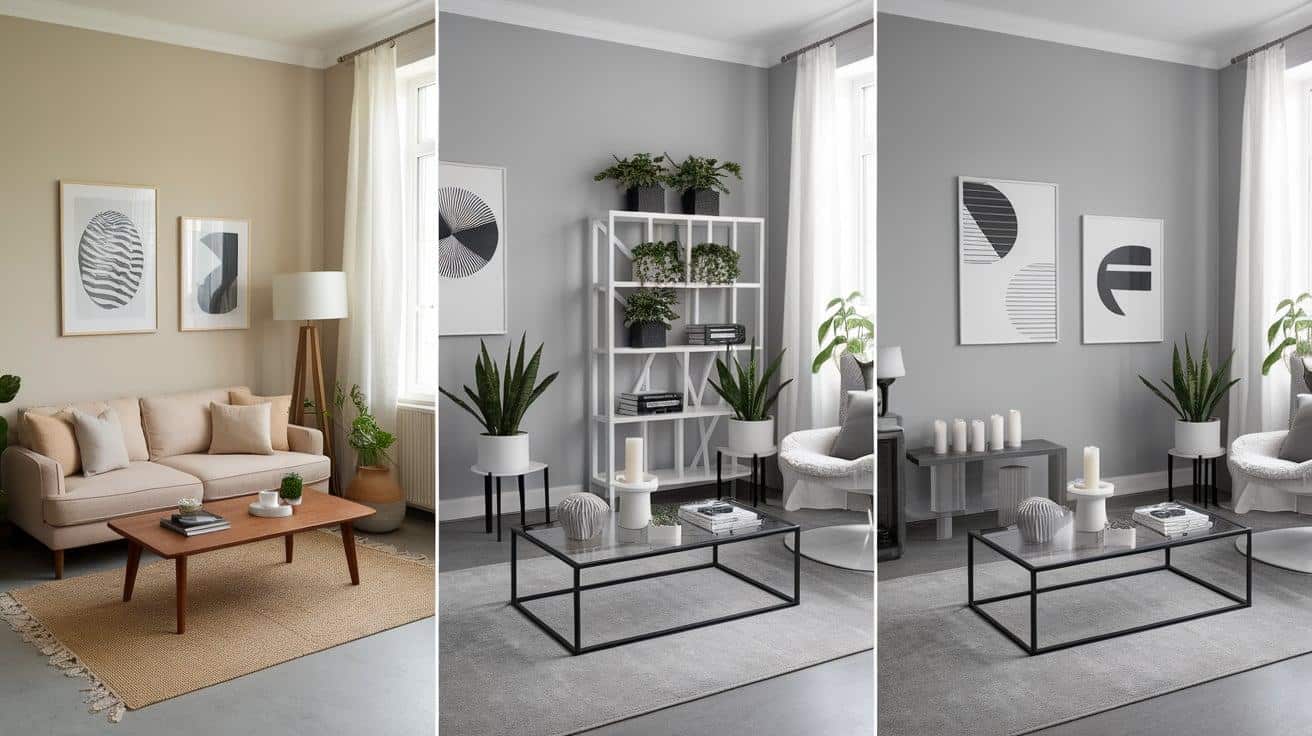
1. Assessing Your Current Décor
Start by evaluating your existing pieces with fresh eyes. Quality items like solid wood furniture and genuine vintage pieces can transition into new styles. Remove items that feel mass-produced or overly trendy.
Create a plan before making changes. Consider which elements support your desired new style and which need replacement. This thoughtful approach helps prevent costly mistakes and ensures a cohesive result.
2. Step-by-Step Guide to Updating Your Home
Begin with wall colors, as they set the foundation for your new style. Choose colors that reflect your selected design direction while complementing existing pieces you plan to keep. Paint offers a significant impact for a relatively low cost.
Focus next on key furniture pieces. Replace dated items with pieces that better suit your new style direction. Consider starting with one room to manage both budget and effort effectively.
3. Budget-Friendly Tips
Transform existing pieces through creative updates. New hardware or paint can refresh dated furniture without major expense, and simple changes like updated lighting fixtures can shift a room’s entire feel.
Visit estate sales and consignment shops for unique pieces with character. These sources often offer quality items at reasonable prices. Plus, incorporating pre-owned items supports sustainability goals.
Incorporating Sustainable and Eco-Friendly Design

Choosing Sustainable Materials
Look for materials certified by recognized environmental organizations. These certifications ensure products meet specific sustainability standards and help guide your choices when selecting new items for your home.
When making selections, consider the longevity of materials. Quality items might cost more initially but often prove more economical over time. They also reduce waste by lasting longer than cheaper alternatives.
Energy-Efficient Upgrades
LED lighting systems provide style and efficiency. Modern fixtures offer form and function, with options for any design style. Smart home features can further enhance convenience and energy savings.
In modern design, window treatments serve dual purposes. They control light and temperature while adding style to spaces. Select options that complement your new design direction while improving home efficiency.
Supporting Ethical Brands
Research companies before making purchases. Many brands now share their sustainability practices and manufacturing processes. This transparency helps consumers make informed choices about their home goods.
Local artisans often provide unique, sustainably crafted items. Supporting these creators helps build community while ensuring quality and originality. Their work adds character that mass-produced items cannot match.
The transition from farmhouse style offers an opportunity to create more personal, sustainable spaces.
By thoughtfully selecting new elements while honoring quality existing pieces, homes can evolve to reflect current trends and timeless styles.
Conclusion
As home design moves beyond the farmhouse era, the possibilities for creating your ideal living space have expanded.
The key is selecting elements that speak to your preferences while building a comfortable, livable environment.
Whether you choose the clean simplicity of Japandi or the expressive nature of maximalism, focus on quality materials and thoughtful design choices.
Remember that good design isn’t about following trends perfectly—creating spaces where you feel at home.
Explore these new styles, include what resonates with you, and craft spaces that will bring joy for years.

